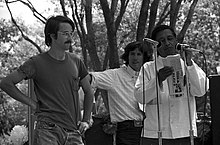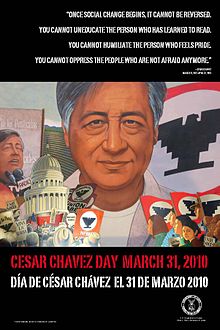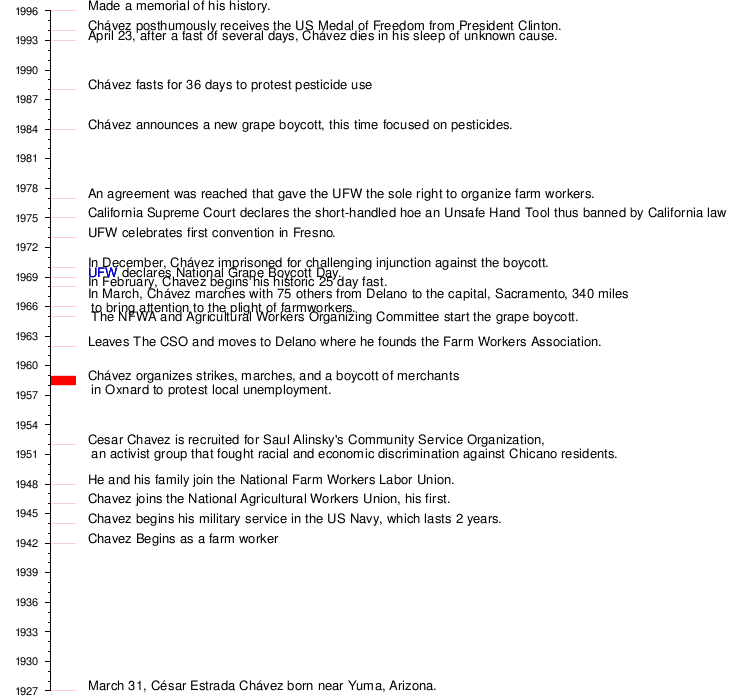César Chávez
From Wikipedia, the free encyclopediaThis article is about the civil rights activist. For the boxer, see Julio César Chávez. For the ship, see USNS Cesar Chavez (T-AKE-14).César Estrada Chávez (Spanish pronunciation: [ˈsesaɾ esˈt̪ɾaða ˈtʃaβes]; March 31, 1927 – April 23, 1993) was an American farm worker, labor leader, and civil rights activist who, with Dolores Huerta, co-founded the National Farm Workers Association, which later became the United Farm Workers (UFW).[1]
César Chávez
César Chávez, 1974Born March 31, 1927
Yuma, Yuma, USDied April 23, 1993 (aged 66)
San Luis, San LuisOccupation Farm worker, labor leader, and civil rights activist. Parents Librado Chávez (father)
Juana Estrada Chávez (mother)
A Mexican American, Chávez became the best known Latino civil rights activist, and was strongly promoted by the American labor movement, which was eager to enroll Hispanic members. His public-relations approach to unionism and aggressive but nonviolent tactics made the farm workers' struggle a moral cause with nationwide support. By the late 1970s, his tactics had forced growers to recognize the UFW as the bargaining agent for 50,000 field workers in California and Florida. However, by the mid-1980s membership in the UFW had dwindled to around 15,000.
Chavez was a charismatic, gifted speaker who inspired Latinos to band together and devote themselves to the farmworkers' movement. Claiming as his models Emiliano Zapata, Gandhi, Nehru, and Martin Luther King, he called on his people to "Make a solemn promise: to enjoy our rightful part of the riches of this land, to throw off the yoke of being considered as agricultural implements or slaves. We are free men and we demand justice."[citation needed]
After his death he became a major historical icon for the Latino community, and for liberals generally, symbolizing militant support for workers and for Hispanic power based on grass roots organizing and his slogan "Sí, se puede" (Spanish for "Yes, it is possible" or, roughly, "Yes, it can be done"). His supporters say his work led to numerous improvements for union laborers. His birthday has become César Chávez Day, a state holiday in eight US states. Many parks, cultural centers, libraries, schools, and streets have been named in his honor in cities across the United States.
Contents
[hide]Early life
César Estrada Chávez was born on March 31, 1927 in Yuma, Arizona, in a Mexican-American family of six children.[2] He was named after his grandfather, Cesario.[3] Chávez grew up in a small adobe home, the same home in which he was born. His family owned a grocery store and a ranch, but their land was lost during the Great Depression. Chávez experienced injustice early in life; his home was taken away after his father had agreed to clear eighty acres of land in exchange for the deed to the house, an agreement which was subsequently broken. Later when Cesar's father attempted to purchase the house, he could not pay the interest on the loan and the house was sold to its original owner.[3] His family then moved to California to become migrant farm workers.
The Chávez family faced many hardships in California. The family would pick peas and lettuce in the winter, cherries and beans in the spring, corn and grapes in the summer, and cotton in the fall.[2] Working conditions for migrant workers were poor and often unsafe, and their wages were low. Cesar's family frequently lacked access to such basic needs as clean water or toilets. Because a large number of migrant workers were Mexican-American, they also often faced prejudice, and their children had to skip school to earn wages to help support the family. When César was a teenager, he and his older sister Rita would help other farm workers and neighbors by driving those unable to drive to the hospital to see a doctor.[4]
Although he was a bright student, Chávez faced difficulty in school due to prejudice. His family spoke only Spanish at home, and his teachers forbade him from speaking the language at school. At one time, Chávez was hit on the knuckles with a ruler for violating this rule.[3] Also at school, he constantly faced hearing racial slurs. In 1942, he graduated from eighth grade. He did not want his mother to have to work in the fields, so he never attended high school, instead dropping out to become a full-time migrant farm worker.[3] In 1944 he joined the United States Navy at the age of seventeen and served for two years. Serving on a ship, he was seasick most of the time. Chávez had hoped that he would learn skills in the Navy that would help him later when he returned to civilian life. However he soon discovered to his dismay that Mexican-Americans in the Navy at that time could only work as deckhands or painters.[5] Later, Chávez described his experience in the military as “the two worst years of my life.”[6] When Chávez returned home from his service in the military, he married his high school sweetheart, Helen Favela. The couple moved to San Jose, California, where they would have seven children: Fernando, Linda (1951–2000),[7] Paul, Eloise, Sylvia and Anthony.[6]
Activism
Chávez worked in the fields until 1952, when he became an organizer for the Community Service Organization (CSO), a Latino civil rights group. He was hired and trained by Fred Ross as an organizer targeting police brutality. Chávez urged Mexican Americans to register and vote, and he traveled throughout California and made speeches in support of workers' rights. He later became CSO's national director in 1958.[8]
In 1962 Chávez left the CSO and co-founded the National Farm Workers Association (NFWA) with Dolores Huerta. It was later called the United Farm Workers (UFW).
When Filipino American farm workers initiated the Delano grape strike on September 8, 1965, to protest for higher wages, Chávez eagerly supported them. Six months later, Chávez and the NFWA led a strike of California grape pickers on the historic farmworkers march from Delano to the California state capitol in Sacramento for similar goals. The UFW encouraged all Americans to boycott table grapes as a show of support. The strike lasted five years and attracted national attention. In March 1966, the US Senate Committee on Labor and Public Welfare's Subcommittee on Migratory Labor held hearings in California on the strike. During the hearings, subcommittee member Robert F. Kennedy expressed his support for the striking workers.[9]
These activities led to similar movements in Southern Texas in 1966, where the UFW supported fruit workers in Starr County, Texas, and led a march to Austin, in support of UFW farm workers' rights. In the Midwest, César Chávez's movement inspired the founding of two Midwestern independent unions: Obreros Unidos in Wisconsin in 1966, and the Farm Labor Organizing Committee (FLOC) in Ohio in 1967. Former UFW organizers would also found the Texas Farm Workers Union in 1975.
In the early 1970s, the UFW organized strikes and boycotts—including the Salad Bowl strike, the largest farm worker strike in U.S. history—to protest for, and later win, higher wages for those farm workers who were working for grape and lettuce growers. The union also won passage of the California Agricultural Labor Relations Act, which gave collective bargaining rights to farm workers. During the 1980s, Chávez led a boycott to protest the use of toxic pesticides on grapes. Bumper stickers reading "NO GRAPES" and "UVAS NO"[10] (the translation in Spanish) were widespread. He again fasted to draw public attention. UFW organizers believed that a reduction in produce sales by 15% was sufficient to wipe out the profit margin of the boycotted product. These strikes and boycotts generally ended with the signing of bargaining agreements.[clarification needed]
Chávez undertook a number of spiritual fasts, regarding the act as “a personal spiritual transformation”.[11] In 1968, he fasted for 25 days, promoting the principle of nonviolence.[12] In 1970, Chávez began a fast of ‘thanksgiving and hope’ to prepare for pre-arranged civil disobedience by farm workers.[13] Also in 1972, he fasted in response to Arizona’s passage of legislation that prohibited boycotts and strikes by farm workers during the harvest seasons.[13] These fasts were influenced by the Catholic tradition of doing penance and by Gandhi’s fasts and emphasis of nonviolence.[12]
In a failed attempt to reach out to Filipino American farmworkers, Chávez met with then-President of the Philippines Ferdinand Marcos in Manila. There he endorsed the regime, which was seen by human rights advocates and religious leaders as a vicious dictatorship. This caused a rift within the UFW, which lead to Philip Vera Cruz's resignation from the organization.[14][15][16][17]
Immigration
The UFW during Chávez's tenure was committed to restricting immigration. Chávez and Dolores Huerta, cofounder and president of the UFW, fought the Bracero Program that existed from 1942 to 1964. Their opposition stemmed from their belief that the program undermined US workers and exploited the migrant workers. Since the Bracero program ensured a constant supply of cheap immigrant labor for growers, immigrants could not protest any infringement of their rights, lest they be fired and replaced. Their efforts contributed to Congress ending the Bracero Program in 1964. In 1973, the UFW was one of the first labor unions to oppose proposed employer sanctions that would have prohibited hiring undocumented immigrants. Later during the 1980s, while Chávez was still working alongside Huerta, he was key in getting the amnesty provisions into the 1986 federal immigration act.[18]
On a few occasions, concerns that undocumented migrant labor would undermine UFW strike campaigns led to a number of controversial events, which the UFW describes as anti-strikebreaking events, but which have also been interpreted as being anti-immigrant. In 1969, Chávez and members of the UFW marched through the Imperial and Coachella Valleys to the border of Mexico to protest growers' use of undocumented immigrants as strikebreakers. Joining him on the march were both Reverend Ralph Abernathy and US Senator Walter Mondale.[19] In its early years, Chávez and the UFW went so far as to report undocumented immigrants who served as strikebreaking replacement workers, as well as those who refused to unionize, to the Immigration and Naturalization Service.[20][21][22][23][24]
In 1973, the United Farm Workers set up a "wet line" along the United States-Mexico border to prevent Mexican immigrants from entering the United States illegally and potentially undermining the UFW's unionization efforts.[25] During one such event in which Chávez was not involved, some UFW members, under the guidance of Chávez's cousin Manuel, physically attacked the strikebreakers, after attempts to peacefully persuade them not to cross the border failed.[26][27][28]
Education
Later in life, Chávez focused on his education. The walls of his office in Keene, California (United Farm Worker headquarters) were lined with hundreds of books ranging in subject from philosophy, economics, cooperatives, and unions, to biographies of Gandhi and the Kennedy family. Chávez was a vegan because he believed in animal rights and also for his health.[29][30]
César Chávez Day
César Chávez's birthday, March 31, is celebrated in California as a state holiday, intended to promote service to the community in honor of Chávez's life and work. Many, but not all, state government offices, community colleges, and libraries are closed. Only two public school districts in San Jose observe the day with no school. Texas also recognizes the day, and it is an optional holiday in Arizona and Colorado.
Legacy
He is buried at the National Chavez Center, on the headquarters campus of the United Farm Workers of America (UFW), at 29700 Woodford-Tehachapi Road in the Keene community of unincorporated Kern County, Kern County.[31] There is a portrait of him in the National Portrait Gallery in Washington, DC.[32]
Colegio César Chávez advertisement in the 1980 Mount Angel Oktoberfest issue of the Silverton Appeal Tribune.
In 1973, college professors in Mount Angel, Oregon established the first four-year Mexican-American college in the United States. They chose César Chávez as their symbolic figurehead, naming the college Colegio Cesar Chavez. In the book Colegio Cesar Chavez, 1973-1983: A Chicano Struggle for Educational Self-Determination author Carlos Maldonado writes that Chávez visited the campus twice, joining in public demonstrations in support of the college. Though Colegio Cesar Chavez closed in 1983, it remains a recognized part of Oregon history. On its website the Oregon Historical Society writes, "Structured as a 'college-without-walls,' more than 100 students took classes in Chicano Studies, early childhood development, and adult education. Significant financial and administrative problems caused Colegio to close in 1983. Its history represents the success of a grassroots movement."[33] The Colegio has been described as having been a symbol of the Latino presence in Oregon.[34]
In 1992, Chávez was awarded the Pacem in Terris Award. It was named after a 1963 encyclical letter by Pope John XXIII that calls upon all people of good will to secure peace among all nations. Pacem in Terris is Latin for "Peace on Earth."
Chávez died on April 23, 1993, of unspecified natural causes in a rental apartment in San Luis, Arizona. Shortly after his death, his widow, Helen Chávez, donated his black nylon union jacket to the National Museum of American History, a branch of the Smithsonian.[35]
On September 8, 1994, Chávez was presented, posthumously, with the Presidential Medal of Freedom by President Bill Clinton. The award was received by his widow, Helen Chávez.
The California cities of Long Beach, Modesto, Sacramento, San Diego, Berkeley, and San Jose, California have renamed parks after him, as well as the City of Seattle, Washington. In Amarillo, Texas a bowling alley has been renamed in his memory. In Los Angeles, César E. Chávez Avenue, originally two separate streets (Macy Street west of the Los Angeles River and Brooklyn Avenue east of the river), extends from Sunset Boulevard and runs through East Los Angeles and Monterey Park. In San Francisco, César Chávez Street, originally named Army Street, is named in his memory. At San Francisco State University the student center is also named after him. The University of California, Berkeley, has a César E. Chávez Student Center, which lies across Lower Sproul Plaza from the Martin Luther King, Jr., Student Union. California State University San Marcos's Chavez Plaza includes a statue to Chávez. In 2007, The University of Texas at Austin unveiled its own César Chávez Statue[36] on campus. Fresno named an adult school, where a majority percent of students' parents or themselves are, or have been, field workers, after Chávez. In Austin, Texas, one of the central thoroughfares was changed to César Chávez Boulevard. In Ogden, Utah, a four-block section of 30th Street was renamed Cesar Chavez Street. In Oakland, there is a library named after him and his birthday, March 31, is a district holiday in remembrance of him. On July 8, 2009, the city of Portland, Portland, changed the name of 39th Avenue to Cesar Chavez Boulevard.[37] In 2003, the United States Postal Service honored him with a postage stamp. The largest flatland park in Phoenix Arizona is named after Chavez. The park features Cesar Chavez Branch Library and a life-sized statue of Chavez by artist Zarco Guerrero. In April, 2010, the city of Dallas, Texas changed street signage along the downtown street-grade portion of Central Expressway, renaming it for Chávez;[38] part of the street passes adjacent to the downtown Dallas Farmers Market complex. El Paso has a controlled-access highway, the portion of Texas Loop 375 running beside the Rio Grande, called the Cesar Chavez Border Highway; also in El Paso, the alternative junior-senior high school in the Ysleta Independent School District is named for Chavez. Las Cruces, New Mexico has an elementary school named for Cesar Chavez as well.
In 2004, the National Chavez Center was opened on the UFW national headquarters campus in Keene by the Cesar E. Chavez Foundation. It currently consists of a visitor center, memorial garden and his grave site. When it is fully completed, the 187-acre (0.76 km2) site will include a museum and conference center to explore and share Chávez's work.[31]
In 2005, a César Chávez commemorative meeting was held in San Antonio, honoring his work on behalf of immigrant farmworkers and other immigrants. Chavez High School in Houston is named in his honor, as is Cesar E. Chavez High School in Delano, California. In Davis, California; Santa Fe, New Mexico; Bakersfield, California and Madison, Wisconsin there are elementary schools named after him in his honor. In Davis, California, there is also an apartment complex named after Chávez which caters specifically to low-income residents and people with physical and mental disabilities. In Racine, Wisconsin, there is a community center named The Cesar Chavez Community Center also in his honor. In Grand Rapids, Michigan, the business loop of I-196 Highway is named "Cesar E Chavez Blvd." The (AFSC) American Friends Service Committee nominated him three times for the Nobel Peace Prize.[39]
On December 6, 2006, California Governor Arnold Schwarzenegger and First Lady Maria Shriver inducted César Chávez into the California Hall of Fame located at The California Museum for History, Women, and the Arts.[40]
César Chávez's eldest son, Fernando Chávez, and grandson, Anthony Chávez, each tour the country, speaking about his legacy.
Chávez was referenced by Stevie Wonder in the song "Black Man," from the album Songs in the Key of Life, and by Tom Morello in the song "Union Song," from the album One Man Revolution.
On May 18, 2011, Navy Secretary Ray Mabus announced the Navy would be naming the last of 14 Lewis and Clark-class cargo ships after Cesar Chavez.[41]
Timeline
This is a free-speech blog and is not owned by the corporations or the rich and powerful. This is a blog of the people. I am a environmentalist socialist (kind of like what they have in Sweeden). Feel free to comment on this blog or give constructive criticism of this free-speech online newspaper.
-Quote from George Washington-
"When the government fears the people, we have liberty, but when the people fear the government, we have tyranny." - George Washington, American Revolutionary and first President of the USA
Sunday, July 24, 2011
Cesar Chavez
Subscribe to:
Post Comments (Atom)





No comments:
Post a Comment